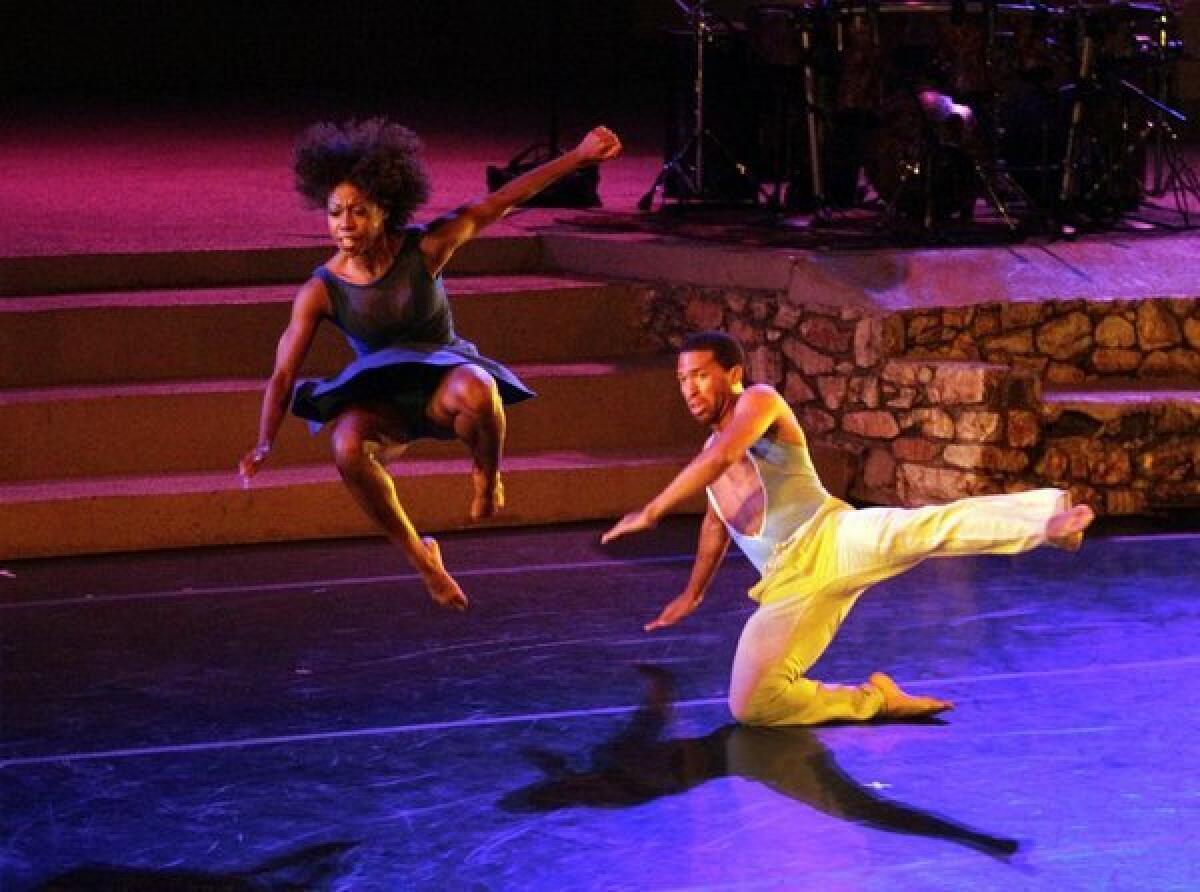Review: Lula Washington dance troupe teams with Complexions

Putting together L.A.’s Lula Washington Dance Theatre and New York’s Complexions Contemporary Ballet for a shared program was not an obvious pairing.
But when the sky darkened, the lights came on and the dancing began outdoors Saturday evening in the John Anson Ford Amphitheatre’s sylvan setting, these companies proved a felicitous, complementary couple. Because, at base, the groups’ two chief choreographer-artistic directors, Lula Washington and Dwight Rhoden, respectively, are devoted mix masters. They share a commitment, not just an artist’s fancy, to scooping up movement, styles and cultural references as ingredients for a product they hope will be powerfully unique. Sometimes they succeed; other times -- just as often, actually -- the results turn out less well.
But one of the fascinating consequences of this union, organized by the Ford for its inaugural Zev Yaroslavsky Signature Series, was how the strengths and weaknesses within individual pieces were more fully revealed.
PHOTOS: Hollywood stars on stage
For this special occasion, Washington premiered the three-part “Turn the Page,” which she initially intended as a tribute to L.A. County Supervisor Yaroslavsky, a classical music-lover. The news of George Zimmerman’s not-guilty verdict in the shooting of Trayvon Martin sidetracked her in mid-process, however, and to express her dismay, she added a solo—a narrow and restricted offering, sadly, to Samuel Barber’s Adagio for Strings. Even the incomparable Bernard Brown could not make it meaningful.
“Turn” began to the iconic opening movement of Beethoven’s Fifth Symphony, used also in an inadequate and limited way as a balletic competition between Brown and Jeremiah Tatum for the attentions of Naila Ansari. Ra’JahNae Patterson was charming as a representative of adolescent innocence, although the lollipop was an unnecessary and regrettable prop.
“We Wore the Mask” (2007), on the other hand, is among Washington’s best pieces. It delivers unflinching social commentary that is revelatory, vigorous and joyful, with sensitive live percussion accompaniment by Marcus L. Miller. Queala Clancy used crisp gestures to create an exacting portrait of liberation.
Excerpts from “Ode to the ’60s” (2007) contained more contrasting examples of Washington’s mawkish side and her expertise with uplifting vernacular dance; the latter bloomed in the section “Super Bad” to James Brown’s rousing R&B hit.
PHOTOS: Arts and culture in pictures by The Times
Also on the program: a love-lust duet from Christopher Huggins’ 2010 ballet “Love Is…,” to which Micah Moch and Khilea Douglass brought realistic heat and thrilling abandon.
After intermission, Complexions’ elite performers stretched, flexed and leaped through seven selections (mostly excerpts) by Rhoden; his dancers’ devoted, full-bodied daring raised the choreographer’s minor efforts several notches.
“I Wonder Why,” one part of an all-Stevie Wonder dance that will premiere in November, was a tepid response to the pop star’s infectious melodies of “Another Star”; the nicest moment was when Washington’s dancers joined Complexions onstage. In 2008’s “Rise,” to hits by U2, Rhoden’s fleet-footed, jig-inflected steps sought to exemplify the exaltation in the music. His efforts were overwhelmed by the pop group’s sheer potency.
Instead, it is when Rhoden relies on his signature hard-edged, distorted technique that the company fully demonstrates its allure. Co-artistic director Desmond Richardson, still a thrilling virtuoso performer, scored an immediately devastating portrait as a vulnerable lover with a bouquet of red flowers in 1991’s “Moonlight.”
Another highlight was a selection from “The Curve” (2012), ballet steps and music sampled for showy aggression. In her final Complexions performance, Christina Dooling made it hard to watch her personification of the abused girlfriend--she was just that good--opposite Edgar Anido’s batterer boyfriend in a nasty but effective duo from “On Holiday” (2010).
The program included another emotive pas de deux, “Testament,” and the more classical but banal duet, “Choke.” Terk Waters, Mark Caserta and Ashley Nicole Mayeux were standouts among these uncommonly outstanding dancers.
ALSO:
‘Mona Lisa’s’ identity could be revealed through DNA testing
Michael Urie conjures a ‘taste” of Streisand in ‘Buyer and Cellar”
Lula Washington Dance Theatre, Complexions Contemporary Ballet pair up
More to Read
The biggest entertainment stories
Get our big stories about Hollywood, film, television, music, arts, culture and more right in your inbox as soon as they publish.
You may occasionally receive promotional content from the Los Angeles Times.










